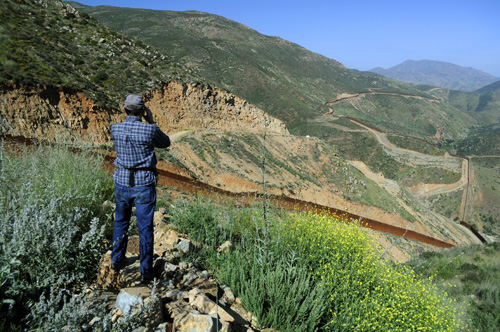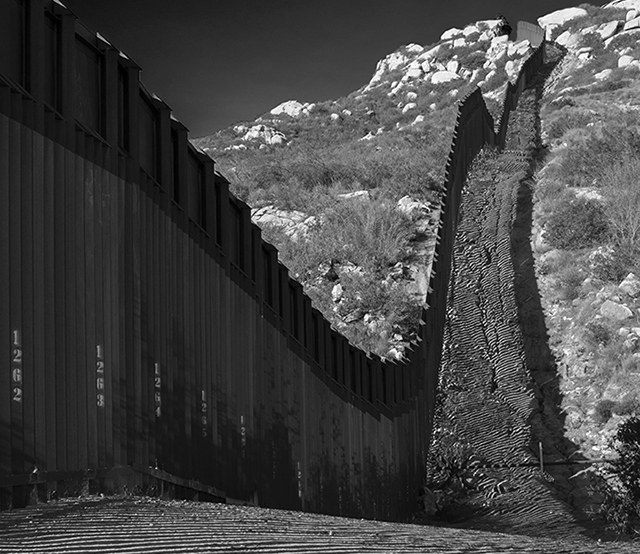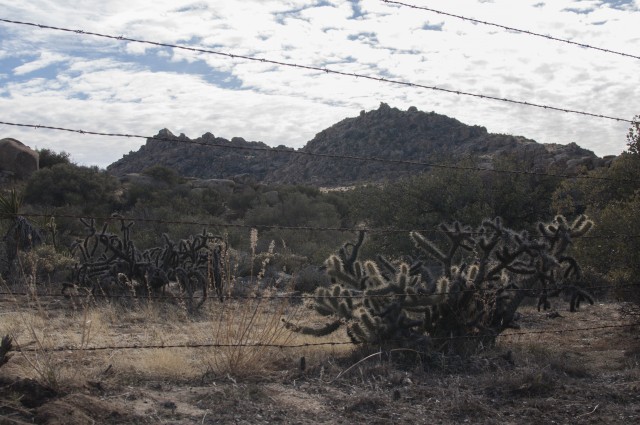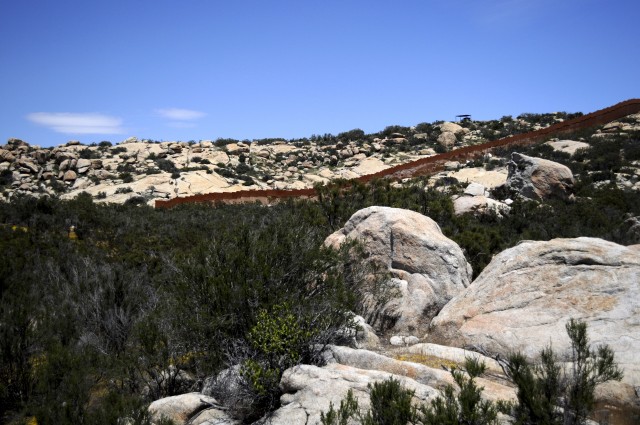|
The Binational Backcountry
October 2016
By Maria E Curry
 Otay Mountain wilderness |
 Tecate Peak |
 La Rumorosa |
 Jacumba. All photos courtesy Jill Marie Holslin |
San Diego's backcountry meets Mexico at the international border with Tecate. The U.S. side is mostly rural, while the Mexican side is more urbanized. There are various heritage corridors that tell the history of people who used the land in the border backcountry. Trails, railroads, old roads, and rivers cross the mountains, canyons and desert of both nations. Historically, the lack of a precise border allowed people, animals, and products to roam the area freely. This changed, especially after 9/11, with the building of the metal border fence, which has grown into a wall.
The wall as a dividing line is another symbol of recent shared social and political binational history. The border wall separates indigenous groups from the Yuman cultural group and descendants of the Kumeyaay, who are present in Tecate and in Campo, California. Artists and social activists organize protests and present art installations, murals, altars, monuments, and cultural events, mostly in Mexico, to mitigate its negative impact.
This area has a biologically diverse and unique landscape. It consists of low and high mountains, mountainous deserts, and desert plateaus. Otay Mountains, Tecate Peak, and Cerro Cuchuma are visual landmarks in this region.
In Tecate, the ecosystems include chaparral, pine forest, and desert scrub. To a lesser extent, there are oak groves, meadowlands, and aquatic and riparian plant areas. Tecate's flora is comparable to Southern California in general and to San Diego County in particular. The diversity and number of plants are still not known, and they need to be cataloged before they are lost. Deforestation, fires, farming, soil removal, urbanization-and the border fence all threaten the natural vegetation.
The rural valley settlements of Jacumba, California and Jacume, Baja California meet in the most homogenous and preserved binational area of the backcountry. It also has rugged topography that has thwarted efforts to build the fence. Where it has been installed, environmentalists on both sides of the border are concerned about its impact on fragile habitats and indigenous fauna, such as rattlesnakes, coyotes, mountain lions, and scorpions. They also fear for nesting areas and wildlife pathways.
The wall not only contributes to the loss of original habitat, reduction of habitat size, and species isolation, it also causes serious flooding and dangerous landslides on the now barren hillsides in the Otay Mountain Wilderness Area. This wilderness is perhaps one of the most heavily guarded and closely watched international boundaries in the world. The fence has been expensive and environmentally destructive, ineffective or deadly, and plagued by technical problems.
According to some border security experts, the Otay mountain range and the deserts of La Rumorosa and Tecate do not need a fence because the harsh terrain is enough of a deterrent to migrants. They argue there is no reason to disrupt the land when the land itself presents a physical barrier.
Wall building along the U.S.-Mexico border completely ignores serious environmental consequences to wildlife, wild lands, and the general ecology of the borderlands region as well as harming cultural resources. Backcountry areas are among the last places relatively untouched by humans, and they should stay that way. Securing the border should continue, but in a more effective way without adversely affecting the natural and cultural border environment.
|
2025
2024
2023
2022
2021
2020
2019
2018
2017
2016
2015
|







